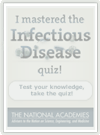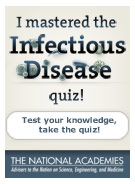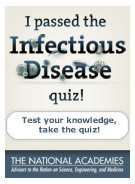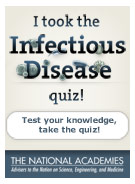
What You Need To Know About Infectious Disease
What do you know about infectious disease?
Which is the vector (animal that carries the pathogen) for West Nile virus?
-
Sorry, that’s incorrect.
The mosquito is the vector for West Nile virus. The mosquito suffers no ill effects from the virus but transmits it to humans and other warm-blooded creatures (such as crows) when it takes a blood meal.
-
Correct!
The mosquito is the vector for West Nile virus. The mosquito suffers no ill effects from the virus but transmits it to humans and other warm-blooded creatures (such as crows) when it takes a blood meal.
-
Sorry, that’s incorrect.
The mosquito is the vector for West Nile virus. The mosquito suffers no ill effects from the virus but transmits it to humans and other warm-blooded creatures (such as crows) when it takes a blood meal.
-
Sorry, that’s incorrect.
The mosquito is the vector for West Nile virus. The mosquito suffers no ill effects from the virus but transmits it to humans and other warm-blooded creatures (such as crows) when it takes a blood meal.
What fraction of all deaths worldwide are caused by infectious disease?
-
Sorry, that’s incorrect.
About one quarter of all deaths worldwide are caused by infectious disease. More than two-thirds of the deaths in children under the age of five are caused by infectious disease.
-
Correct!
About one quarter of all deaths worldwide are caused by infectious disease. More than two-thirds of the deaths in children under the age of five are caused by infectious disease.
-
Sorry, that’s incorrect.
About one quarter of all deaths worldwide are caused by infectious disease. More than two-thirds of the deaths in children under the age of five are caused by infectious disease.
For which of the following diseases do we currently lack an effective vaccine for prevention?
-
Sorry, that’s incorrect.
Although there are treatments available in the form of antivirals, we still currently lack a vaccine for HIV.
-
Sorry, that’s incorrect.
Although there are treatments available in the form of antivirals, we still currently lack a vaccine for HIV.
-
Correct!
Although there are treatments available in the form of antivirals, we still currently lack a vaccine for HIV.
-
Sorry, that’s incorrect.
Although there are treatments available in the form of antivirals, we still currently lack a vaccine for HIV.
Which of these viral diseases has the most antiviral drugs available to treat it?
-
Sorry, that’s incorrect.
Today there are more antiviral drugs available for HIV than for any other viral disease, transforming an infection that was once considered a death sentence into a manageable chronic condition.
-
Correct!
Today there are more antiviral drugs available for HIV than for any other viral disease, transforming an infection that was once considered a death sentence into a manageable chronic condition.
-
Sorry, that’s incorrect.
Today there are more antiviral drugs available for HIV than for any other viral disease, transforming an infection that was once considered a death sentence into a manageable chronic condition.
-
Sorry, that’s incorrect.
Today there are more antiviral drugs available for HIV than for any other viral disease, transforming an infection that was once considered a death sentence into a manageable chronic condition.
Due in large measure to the toll of infectious diseases, the gap in life expectancy between the richest and poorest countries now exceeds how many years?
-
Sorry, that’s incorrect.
The gap in life expectancy between the richest and poorest countries now exceeds 40 years.
-
Sorry, that’s incorrect.
The gap in life expectancy between the richest and poorest countries now exceeds 40 years.
-
Correct!
The gap in life expectancy between the richest and poorest countries now exceeds 40 years.
-
Sorry, that’s incorrect.
The gap in life expectancy between the richest and poorest countries now exceeds 40 years.
Since the beginning of the 20th century, the number of people in the world has:
-
Sorry, that’s incorrect.
Since the beginning of the 20th century the number of people in the world has more than quadrupled—from 1.6 billion to nearly 7 billion—and world population is expected to rise to well over 9 billion by 2050.
-
Sorry, that’s incorrect.
Since the beginning of the 20th century the number of people in the world has more than quadrupled—from 1.6 billion to nearly 7 billion—and world population is expected to rise to well over 9 billion by 2050.
-
Correct!
Since the beginning of the 20th century the number of people in the world has more than quadrupled—from 1.6 billion to nearly 7 billion—and world population is expected to rise to well over 9 billion by 2050.
Which of the following is NOT a type of infectious agent?
-
Sorry, that’s incorrect.
White blood cells are not a type of infectious agent. Part of the immune system, white blood cells fight infection rather than cause it.
-
Sorry, that’s incorrect.
White blood cells are not a type of infectious agent. Part of the immune system, white blood cells fight infection rather than cause it.
-
Correct!
White blood cells are not a type of infectious agent. Part of the immune system, white blood cells fight infection rather than cause it.
-
Sorry, that’s incorrect.
White blood cells are not a type of infectious agent. Part of the immune system, white blood cells fight infection rather than cause it.
Each year, how many Americans become infected by what they eat?
-
Sorry, that’s incorrect.
Each year about 76 million Americans—or one in four—become infected by what they eat. Approximately 325,000 are hospitalized. More than 5,000 (14 a day) die.
-
Sorry, that’s incorrect.
Each year about 76 million Americans—or one in four—become infected by what they eat. Approximately 325,000 are hospitalized. More than 5,000 (14 a day) die.
-
Correct!
Each year about 76 million Americans—or one in four—become infected by what they eat. Approximately 325,000 are hospitalized. More than 5,000 (14 a day) die.
For each child who dies from pneumonia in an industrialized country, about how many children die from the infection in developing countries?
-
Sorry, that’s incorrect.
Life-saving vaccines and medications aren’t distributed equitably around the world; for each child who dies from pneumonia in an industrialized country, more than 2,000 children die from the infection in developing countries.
-
Sorry, that’s incorrect.
Life-saving vaccines and medications aren’t distributed equitably around the world; for each child who dies from pneumonia in an industrialized country, more than 2,000 children die from the infection in developing countries.
-
Sorry, that’s incorrect.
Life-saving vaccines and medications aren’t distributed equitably around the world; for each child who dies from pneumonia in an industrialized country, more than 2,000 children die from the infection in developing countries.
-
Correct!
Life-saving vaccines and medications aren’t distributed equitably around the world; for each child who dies from pneumonia in an industrialized country, more than 2,000 children die from the infection in developing countries.
Thank you for taking our quiz.
Place this badge on your Facebook page to show your friends what you know about infectious disease.
Place this badge on your Facebook page to show your friends what you know about infectious disease.
OR, get a higher score to unlock a different badge.

Place this badge on your Facebook page to show your friends what you know about infectious disease.
OR, get a higher score to unlock a different badge.

Explore Other Topics
Disease Watchlist
Infectious Disease Defined
- Rhinovirus
A type of virus that is responsible for causing upper respiratory tract infections in humans, otherwise known as the common cold.


